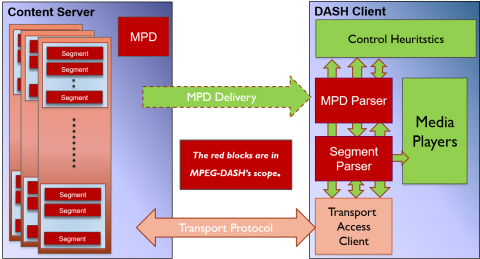
By Philip Merrill - April 2017
With MPEG, certain words have associations and so it is possible to break down the name Dynamic Adaptive Streaming over HTTP. "Adaptive" implies the ability for the client to adapt the experience to available network characteristics, and the Stream is the bitstream so that is MPEG's home turf. "Dynamic" is a word with many implications, mostly challenging use cases, but it is firmly anchored in transmission and the ability to make new insertions more or less at the last instant. This makes the bitstream itself more dynamic, more able to configure and reconfigure screen layouts and media data so that the user-server interaction feels real time for the user. So in several ways, the key word in DASH are the initials "HTTP." Although DASH information can also be delivered using other protocols, DASH has been shaped to the HTTP environment and this has probably contributed to its wide adoption.
DASH represents media and delivery information so that the moment-to-moment relationship between user and server can proceed from the handshake to something more like a waltz. DASH is codec-agnostic so as not to be dependent to any specific codec but to enable delivery of the content in any media format. For MPEG fans the time and media segment information exchange is old hat. Since this news area is for looking around from somewhat of an insider's perspective, it will zoom in on several aspects of DASH that are less well known.
DASH interoperable descriptions and bit structure is an example where discourse can bring benefits in human affairs, getting things done on two sides or even many multiple sides of relationship(s). DASH supports the interrelationship between a server serving media and a customer consuming multiple media titles or other content programming. Whether a user is in a game environment, and/or VR/AR, or moving normally throughout the day, each moment can be filled with media designed to be consumed under that moment's circumstances. However user preferences are configured, appropriate data for what Google calls micro-moments should be served up in an appropriate way. In terms of transmission rates, this means serving sizes that are not too big for the table, so to speak.
Application development in MPEG-A has found tools ready at hand to configure reliable relationships between metadata and bit transmission structure. The question of what problem are we trying to solve does not do justice to consumer appetites and creativity in the digital world as we now find it. Fortunately for MPEG-A, the standardized toolkit MPEG and other organizations have developed can be configured into more complex assemblies, if not readily then close enough. Common Media Application Format pursues this -A app development approach to further abstract the relationship between Manifests including MPD and media Segments.
DASH has been granted somewhat widespread adoption, perhaps a foot in the door for both DASH and the MPEG way of doing things. Netflix supports DASH without MPD and YouTube supports DASH with its own video codec. The fundamental separation of information about media from Segments that can exist with adaptation packages in giant data silos of media lets everything be more nimble. By calling into the silo meaningfully and dynamically, the goal is efficient and successful delivery of media files and their configuration metadata.
Although adaptation is in one way what DASH is all about, it is also an area left unspecified. DASH enables experimentation and innovation in the marketplace for interactive and personalized experiences. Other tools including MPEG's can be used as part of private development efforts. DASH interoperable messaging and bitstreams have an important role to play, to set up an ecology that includes private development unfettered by normative requirements. For those who appreciate development, DASH has a particularly rich library of open source software tools as well as an industry forum providing additional resources.
Go to the MPEG news page
